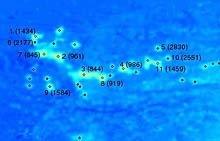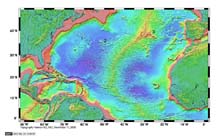This map shows the various peaks of the Corner Rise seamount cluster. The peaks are labeled with arbitrary numbers and are accompanied by estimated summit height, in meters, in parentheses. Click image for larger view and image credit.
Mission Plan
Timothy Shank
Co-Principal Investigator
Woods Hole Oceanographic Institution
Les Watling
Benthic Ecologist
University of Maine
During this mission, we will be collecting both living and fossil corals, both hard corals and soft corals. The latter are usually referred to as octocorals or for most of them, gorgonian corals. Living corals will allow us to fill in distributional patterns of corals across the central part of the North Atlantic and so give us clues about how ocean currents can distribute coral larvae. The fossil corals will be used to examine how North Atlantic Ocean currents may have changed in the past and also to determine what the deep ocean climate was like. The New England and Corner Rise seamounts are extremely old, about 110 million years at Bear Seamount (furthest to the west) and about 75 million years at Corner Rise. As a result, these seamounts were present through all the changes in ocean climate experienced by the North Atlantic Ocean. The modern coral fauna, of course, most likely goes back only 20 million years or so, but from the hard corals we will be able to look in detail at the North Atlantic Ocean climate during the past 1 million years.
We will also be collecting animals living on the corals (referred to as epifaunal associates) to examine their diversity and genetic relatedness among seamounts. These associates include asteroids, ophiuroids, galatheids, barnacles, anemones, and sponges. The reasons for studying these organisms are several-fold, including that they are the dominant fauna on all of the New England Seamounts studied to date, and they are present everywhere in the depth range from about 3km to less than 1km. Most importantly, these epifanual associates as well as species not intimately associated with corals will be collected to address current opposing hypotheses that provide a framework in which our results will be interpreted. The geological constraints and circulation patterns imposed on organism dispersal by relatively shallow, steep-sided seamounts may be sufficient to form a barrier to stepping stone dispersal. In contrast, the primary dispersal route for maintaining deep-sea populations in the Northern Atlantic may be via a series of seamounts acting as 'stepping stones'.
This map shows the relative positions of the long New England seamount chain (1), the Corner Rise seamount cluster (2), and the Azores platform (3) just to the east and adjoining the mid-Atlantic Ridge. Click image for larger view and image credit.
Objectives of the cruise are:
1. Determine the taxonomic composition, depth, and biogeographic relationships of corals and associated commensal species of the eastern New England and Corner Rise seamounts.
2. Determine the taxonomic composition and distribution of paleo-fauna and thus deduce the climate history of this region through collection of fossil material.
3. Determine how climate change has shaped the evolutionary history of faunal populations inhabiting the New England and Corner Rise Seamounts.
4. Determine the population genetic and phylogeographic relationships of coral-associated invertebrates shared among the various seamounts to examine whether these seamounts are stepping stones or sites of in-situ evolution.
5. Determine whether seamount corals are genetically isolated between seamounts and from eastern and western Atlantic basins and how current regimes play a role in dispersal.
6. Determine the reproductive state and potential larval strategies of seamount corals.
7. Investigate the colonization dynamics of coral aggregations and how the geomorphology of differing seamounts affects colonization.
8. Determine the relationship of demersal nekton to seamount landscape features with and without corals.
9. Assess the physical impact of bottom trawling on coral communities.
The last objective relates to the fact that the Corner Rise seamounts were subject to fishing by Russian deep-sea trawlers during the 1960s. Although we don't know exactly where these fishing and trawling activities occurred, we know that two Corner Rise seamounts experienced these activities. So, we will watch carefully for signs of past trawling activity and subsequent recruitment during dives in these locations.
We will be diving on three sets of peaks in the Corner Rise area. Because none of the seamounts have official names, we've given them numbers. We will explore peaks 11, 3 and 8 and the adjoining ridge, and 2 and 7 and adjoining ridge (see map). Then we plan to transit westward to dive on Nashville, Rehoboth, Manning, Gosnold, and Physalia seamounts in the New England Seamount Chain.


























